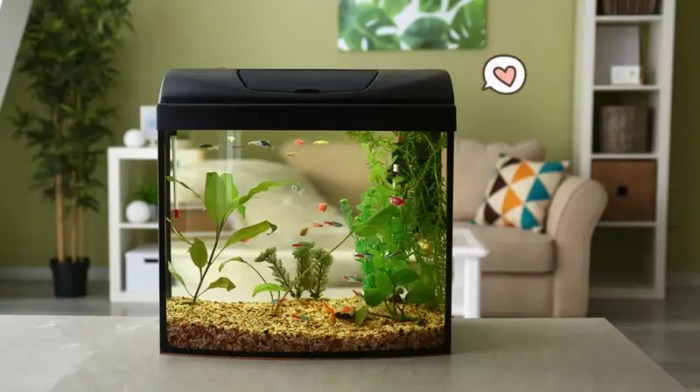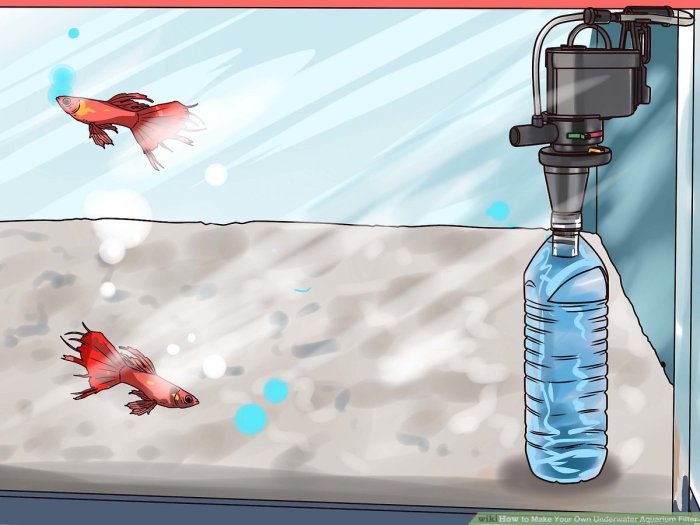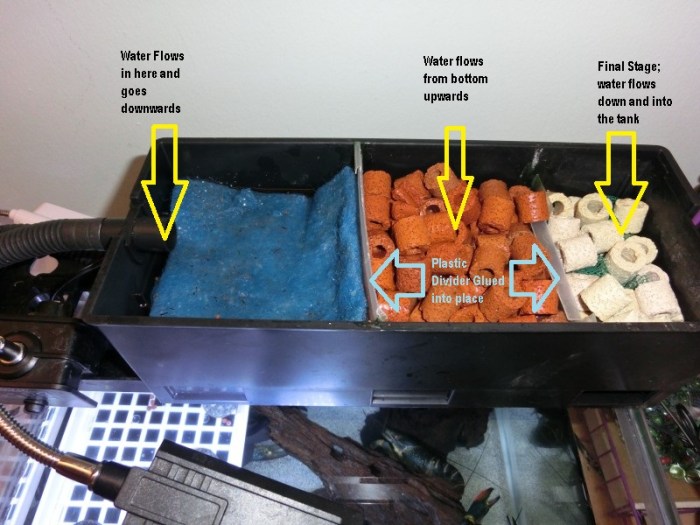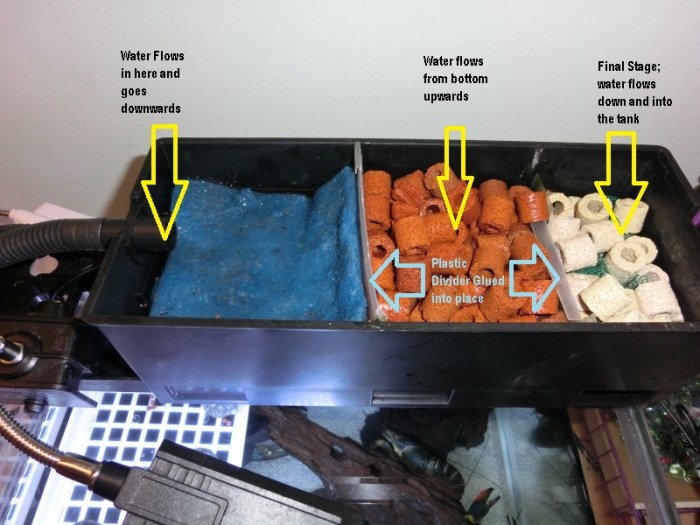DIY aquarium filtration takes center stage, offering a unique and rewarding way to cultivate a thriving underwater world. By crafting your own filtration system, you gain a deeper understanding of the delicate balance within your aquarium, empowering you to create an optimal environment for your aquatic companions. This journey delves into the fundamentals of aquarium filtration, guiding you through the selection of materials, construction techniques, and ongoing maintenance practices.
From understanding the essential roles of mechanical, biological, and chemical filtration to exploring advanced DIY techniques, this comprehensive guide equips you with the knowledge and skills to design, build, and maintain a filtration system that meets the specific needs of your aquarium. Whether you’re a seasoned aquarist or just starting your journey, the rewards of DIY filtration extend beyond cost savings, offering a sense of accomplishment and a deeper connection to your aquatic ecosystem.
Chemical Filtration Options

Chemical filtration plays a crucial role in maintaining water quality in aquariums by removing dissolved organic compounds and toxins that can harm fish and plants. These filtration methods target specific substances and work differently than mechanical filtration, which removes larger particles.
Activated Carbon
Activated carbon is a highly porous material with a large surface area that effectively adsorbs dissolved organic compounds and toxins from aquarium water. It is commonly used to remove:
- Chlorine and Chloramines: These chemicals are often found in tap water and can be harmful to fish. Activated carbon effectively removes them, making the water safe for aquatic life.
- Organic Compounds: Activated carbon can remove various organic compounds, such as tannins, humic acids, and medications, which can affect water clarity and potentially harm fish.
- Toxins: It can also remove certain toxins, including ammonia, nitrite, and nitrates, although its effectiveness in removing these compounds may vary depending on the type and concentration of the toxin.
Activated carbon works by trapping these substances on its surface through a process called adsorption. However, it has a limited capacity and eventually becomes saturated, requiring replacement.
Other Chemical Filtration Methods
Beyond activated carbon, other chemical filtration methods are available to address specific water quality issues:
- Ion Exchange Resins: These resins are designed to remove specific ions from the water, such as calcium, magnesium, and potassium. They are often used to soften hard water, reducing the risk of scale buildup in aquariums.
- Phosphate Removers: These products are specifically designed to remove phosphates from aquarium water. Phosphates can contribute to algae growth, so their removal is crucial for maintaining a balanced ecosystem.
These methods offer targeted solutions for specific water quality problems, but it’s important to choose the appropriate method based on your aquarium’s needs.
Potential Risks and Limitations
While chemical filtration methods can be beneficial, it’s essential to be aware of their potential risks and limitations:
- Over-Filtration: Using excessive amounts of chemical filtration media can deplete essential minerals and nutrients from the water, potentially harming fish and plants.
- Nutrient Depletion: Some chemical filtration methods, like ion exchange resins, can remove beneficial nutrients from the water, which can negatively impact plant growth.
- Release of Unwanted Substances: Some chemical filtration media may release unwanted substances into the water, such as heavy metals or other contaminants, if not properly handled or if they are expired.
- Limited Effectiveness: The effectiveness of chemical filtration can vary depending on the type of media used, the concentration of the target substance, and the flow rate of the water through the filter.
It is important to choose chemical filtration media carefully, follow the manufacturer’s instructions, and monitor water parameters regularly to ensure the health of your aquarium.
Designing a DIY Filtration System
Designing a DIY filtration system for your aquarium can be a rewarding experience, allowing you to customize the filtration process to meet your specific needs and budget. It involves carefully considering the size and stocking levels of your aquarium, choosing the right materials, and understanding the principles of biological, mechanical, and chemical filtration.
DIY Filtration System Designs
The design of your DIY filtration system will depend on your aquarium’s size, the types of fish you keep, and your personal preferences. Here are a few popular DIY filtration system designs:
Hang-on Filters
Hang-on filters are simple and easy to install. They are typically attached to the side of the aquarium and use a small pump to draw water through filter media.
- Simple design: A simple hang-on filter can be created using a plastic container, a pump, and filter media.
- Easy to maintain: Hang-on filters are easy to clean and maintain, as you can simply remove the filter media and rinse it.
- Suitable for small aquariums: Hang-on filters are suitable for smaller aquariums up to 20 gallons.
Canister Filters
Canister filters are more powerful and provide a higher filtration capacity than hang-on filters. They are placed outside the aquarium and use a pump to draw water through a series of filter media.
- Multiple stages of filtration: Canister filters offer multiple stages of filtration, allowing for a more comprehensive approach to water quality.
- Higher filtration capacity: Canister filters can handle larger volumes of water and are suitable for larger aquariums.
- More complex setup: Canister filters require more effort to set up and maintain compared to hang-on filters.
Under-Gravel Filters
Under-gravel filters are a classic filtration system that uses a plate with holes beneath the gravel to create a biological filtration zone. Water is drawn through the gravel and up to the surface, where it is then circulated back through the filter.
- Simple and effective: Under-gravel filters are a simple and effective way to provide biological filtration.
- Less maintenance: Under-gravel filters require less frequent cleaning compared to other filter types.
- Potential for clogging: The gravel can become clogged with debris, reducing the filter’s efficiency.
Choosing the Right Pump and Filter Media, Diy aquarium filtration
The pump and filter media are essential components of any DIY filtration system. Choosing the right ones will ensure that your filter operates efficiently and provides the necessary filtration for your aquarium.
Pump Selection
The pump’s flow rate should be appropriate for the size of your aquarium.
- Flow rate: The flow rate is measured in gallons per hour (GPH) and should be sufficient to circulate the water in your aquarium at least 4-6 times per hour.
- Head pressure: The head pressure refers to the pump’s ability to push water up against gravity. This is important for canister filters and other systems that require the water to be pumped upwards.
- Power consumption: Consider the pump’s power consumption to ensure it’s energy-efficient and won’t strain your electrical system.
Filter Media
The filter media you choose will determine the types of filtration your system provides.
- Mechanical filtration: This removes large particles, such as debris and fish waste, from the water. Common mechanical filter media include sponges, filter floss, and filter pads.
- Biological filtration: This breaks down harmful ammonia and nitrite into less harmful nitrates. Biological filter media typically consists of porous materials that provide a surface area for beneficial bacteria to colonize.
- Chemical filtration: This removes dissolved impurities from the water, such as chlorine and heavy metals. Chemical filter media can include activated carbon, zeolite, and phosphate removers.
DIY Filter Media Creation
Creating your own filter media can be a rewarding and cost-effective way to enhance your aquarium’s filtration system. You can experiment with different recipes and materials to find what works best for your specific needs. This section will delve into DIY filter media creation, exploring recipes, benefits, drawbacks, and a comprehensive table outlining the process for creating different types of DIY filter media.
Homemade Bio-Balls
Homemade bio-balls provide a large surface area for beneficial bacteria to colonize, playing a crucial role in the biological filtration process.
Benefits of Homemade Bio-Balls
- Cost-effectiveness: You can create your own bio-balls using readily available materials, saving you money compared to purchasing commercial options.
- Customization: You can tailor the size, shape, and material of your bio-balls to fit your specific aquarium needs.
- Environmental Sustainability: Using recycled materials can reduce waste and contribute to a more sustainable approach to aquarium maintenance.
Drawbacks of Homemade Bio-Balls
- Durability: Homemade bio-balls may not be as durable as commercially produced ones, potentially breaking down over time.
- Consistency: Achieving consistent results in terms of porosity and surface area can be challenging.
- Potential for Contamination: Improperly sanitized materials can introduce unwanted bacteria or contaminants into your aquarium.
Recipes for Homemade Bio-Balls
- Clay Bio-Balls: Mix air-drying clay with water to create a thick paste. Roll the paste into balls and allow them to dry completely. Once dried, bake the bio-balls in an oven at low heat to harden them.
- Ceramic Bio-Balls: Combine ceramic powder, water, and a binder (such as clay or plaster) to create a moldable mixture. Shape the mixture into balls and allow them to dry completely. You can also bake the ceramic bio-balls in an oven to further harden them.
- Lava Rock Bio-Balls: Crush lava rock into small pieces. Mix the crushed lava rock with a binder (such as epoxy resin or concrete) and mold the mixture into balls. Allow the bio-balls to cure completely before using them in your aquarium.
DIY Activated Carbon
Activated carbon is a highly porous material that effectively removes impurities and toxins from aquarium water.
Benefits of DIY Activated Carbon
- Cost-effectiveness: Creating your own activated carbon can be significantly cheaper than purchasing pre-packaged activated carbon.
- Customization: You can adjust the activation process to tailor the carbon’s properties to your specific needs.
- Environmental Sustainability: Using readily available materials and minimizing waste can contribute to a more environmentally friendly approach.
Drawbacks of DIY Activated Carbon
- Consistency: Achieving consistent activation and pore size can be challenging, potentially affecting its effectiveness.
- Potential for Contamination: Improperly activated carbon can release harmful substances into your aquarium.
- Limited Shelf Life: DIY activated carbon may have a shorter shelf life compared to commercially produced options.
Recipes for DIY Activated Carbon
- Coconut Shell Activated Carbon: Crush coconut shells into small pieces. Heat the crushed shells in a sealed container at high temperatures (around 800-900°C) for several hours to activate the carbon. This process involves removing impurities and increasing the surface area of the carbon.
- Wood Activated Carbon: Cut wood into small pieces and char them in a sealed container at high temperatures. Similar to coconut shell activation, the charring process increases the carbon’s surface area and porosity, making it more effective in absorbing impurities.
- Activated Charcoal: Use commercially available charcoal briquettes or charcoal powder. Heat the charcoal in a sealed container at high temperatures to activate it. This method is simpler than creating activated carbon from scratch but may require careful handling due to the high temperatures involved.
Table of DIY Filter Media Creation
| Filter Media | Materials | Process | Notes |
|—|—|—|—|
| Homemade Bio-Balls | Air-drying clay, water, oven | Mix clay and water to create a paste. Roll into balls and dry completely. Bake in an oven at low heat to harden. | Ensure the clay is oven-safe. |
| | Ceramic powder, water, binder (clay or plaster) | Combine materials and mold into balls. Dry completely. Optionally bake in an oven to harden. | Use a binder that is compatible with aquarium water. |
| | Crushed lava rock, binder (epoxy resin or concrete) | Mix crushed lava rock with binder and mold into balls. Allow to cure completely. | Choose a binder that is non-toxic and safe for aquarium use. |
| DIY Activated Carbon | Coconut shells | Crush coconut shells. Heat in a sealed container at high temperatures (800-900°C) for several hours. | Use a sealed container and appropriate safety precautions when handling high temperatures. |
| | Wood | Cut wood into small pieces and char in a sealed container at high temperatures. | Use a sealed container and appropriate safety precautions when handling high temperatures. |
| | Charcoal briquettes or charcoal powder | Heat charcoal in a sealed container at high temperatures. | Use a sealed container and appropriate safety precautions when handling high temperatures. |
Troubleshooting DIY Aquarium Filtration

DIY aquarium filtration systems offer a cost-effective and customizable approach to maintaining a healthy aquarium environment. However, like any system, they can encounter issues that require troubleshooting. Common problems include clogging, poor flow rate, and bacterial bloom. Understanding these issues and how to resolve them is crucial for ensuring the success of your DIY filtration system.
Identifying Common Problems
It’s important to be aware of common issues that can arise with DIY aquarium filtration systems. These issues can affect water quality and the overall health of your fish. Here are some of the most frequently encountered problems:
- Clogging: Filter media, especially those with fine pores, can become clogged with debris, reducing water flow and filtration efficiency. This can occur due to excessive organic waste, lack of regular cleaning, or the use of inappropriate media.
- Poor Flow Rate: A reduced flow rate can be caused by clogging, pump malfunction, or inadequate pump size for the tank volume. This can lead to stagnant water, reduced oxygen levels, and an accumulation of waste products.
- Bacterial Bloom: A sudden increase in bacteria, often accompanied by cloudy water, can occur due to overfeeding, poor water quality, or inadequate filtration. This can deplete oxygen levels and stress your fish.
Troubleshooting Tips
When encountering problems with your DIY filtration system, there are several troubleshooting steps you can take to restore optimal performance:
- Clean Filter Media: Regularly clean or replace filter media, especially those prone to clogging. Use a gentle stream of aquarium water to remove debris without damaging the media. Avoid using tap water, which can introduce harmful chemicals.
- Adjust Pump Settings: Check the pump settings and ensure they are appropriate for the tank size and water flow requirements. If the pump is too weak or clogged, it may need cleaning or replacement.
- Address Water Quality Issues: Monitor water parameters regularly, including pH, ammonia, nitrite, and nitrate levels. If these parameters are outside the recommended range, take corrective actions, such as partial water changes or the addition of water conditioners.
- Check for Leaks: Inspect the filtration system for any leaks, which can reduce water flow and create an environment for bacterial growth. Seal any leaks promptly.
Importance of Regular Maintenance
Regular maintenance is essential for the long-term success of your DIY filtration system. This includes:
- Cleaning Filter Media: Clean or replace filter media according to the manufacturer’s recommendations. The frequency will depend on the type of media and the bioload of the tank.
- Inspecting Pump: Regularly check the pump for signs of wear or damage. Clean the impeller and ensure it spins freely. Replace the pump if necessary.
- Monitoring Water Parameters: Monitor water quality regularly and make adjustments as needed. This includes testing for pH, ammonia, nitrite, and nitrate levels.
Advanced DIY Filtration Concepts

While basic DIY filtration can effectively maintain a healthy aquarium environment, advanced filtration techniques can further enhance water quality and create more sophisticated ecosystems. These methods involve incorporating specialized components and processes that mimic natural aquatic environments, promoting beneficial bacteria growth and nutrient cycling.
Bio-Wheel Filtration
Bio-wheel filtration utilizes a rotating wheel covered in a porous material that provides a large surface area for beneficial bacteria to colonize. As the wheel rotates, it exposes the bacteria to oxygenated water, enhancing their growth and efficiency in breaking down ammonia and nitrite.
- Increased Surface Area: The rotating wheel provides a significantly larger surface area for bacterial colonization compared to traditional filter media, resulting in a higher bio-filtration capacity.
- Enhanced Oxygenation: The constant rotation of the wheel ensures continuous exposure of the bacteria to oxygenated water, promoting their growth and activity.
- Improved Waste Removal: The increased surface area and enhanced oxygenation contribute to more efficient waste removal, resulting in cleaner water and a healthier aquarium environment.
Refugium Filtration
Refugium filtration utilizes a separate tank, typically a sump, containing live rock, macroalgae, and a substrate that promotes the growth of beneficial bacteria. This creates a mini-ecosystem that removes excess nutrients, provides a refuge for small invertebrates, and adds aesthetic appeal to the aquarium.
- Nutrient Export: Macroalgae effectively absorb nitrates and phosphates, reducing their levels in the main aquarium and preventing algae blooms.
- Biological Filtration: The live rock and substrate provide a habitat for beneficial bacteria that break down ammonia and nitrite, further enhancing water quality.
- Natural Ecosystem: The refugium creates a miniature ecosystem that mimics the natural environment of a reef, promoting biodiversity and enhancing the overall health of the aquarium.
Trickle Filtration
Trickle filtration involves water flowing through a series of layers containing different filter media, such as bio-balls, ceramic rings, and activated carbon. This method promotes the growth of beneficial bacteria and removes pollutants through a combination of biological, chemical, and mechanical filtration.
- Multi-Stage Filtration: The layered media allows for a multi-stage filtration process, effectively removing various pollutants and promoting a balanced aquarium environment.
- Enhanced Aeration: The water cascading through the layers increases oxygenation, benefiting fish and other aquatic life.
- Versatile Media Options: Trickle filters offer flexibility in choosing filter media based on specific aquarium needs, allowing for customization and optimization of water quality.
Embarking on the path of DIY aquarium filtration is a rewarding endeavor that allows you to take control of your aquatic environment. By understanding the principles of filtration and mastering the techniques Artikeld in this guide, you can create a thriving ecosystem that sustains the health and well-being of your fish and other aquatic life. Remember, the journey of DIY filtration is an ongoing process of learning, experimentation, and adaptation. Embrace the challenges and celebrate the successes as you cultivate a unique and flourishing underwater world.
DIY aquarium filtration can be a rewarding project, allowing you to tailor the system to your specific needs. However, it’s crucial to remember that creating a safe and healthy environment for your fish requires careful planning and execution. Just like researching the names of strong sleeping pills, strong sleeping pills names , is essential before starting any DIY project, you must thoroughly research the components and processes involved in aquarium filtration to ensure the well-being of your aquatic companions.

